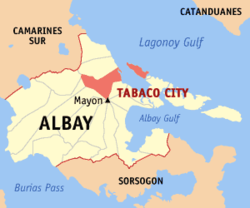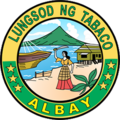Spanish Era (1731–1898)| Inclusive years | Gobernadorcillo |
|---|
| 1731 | Don Martin Aguirre |
|---|
| 1732 | Don Gabriel Tabad |
|---|
| 1733 | Don Pascual Payante |
|---|
| 1734 | Don Francisco Lomalag |
|---|
| 1735 | Don Bartolome Daguinot |
|---|
| 1736 | Don Pedro Gauban |
|---|
| 1737 | Don Antonio Mabangquiray |
|---|
| 1738-1739 | Don Gabriel Tabad |
|---|
| 1740-1741 | Don Antonio Mabangquiray |
|---|
| 1742 | Don Felipe Tiangco |
|---|
| 1743 | Don Gabriel Tabad |
|---|
| 1744 | Don Antonio Mabangquiray |
|---|
| 1745 | Don Sebastian Ortiz |
|---|
| 1746-1750 | Don Juan Flores |
|---|
| 1751 | Don Gabriel Tabad |
|---|
| 1752-1753 | Don Juan Flores |
|---|
| 1754-1755 | Don Manuel dela Cruz |
|---|
| 1756-1757 | Don Hilario Gobarat |
|---|
| 1758 | Don Pedro Manlagñit |
|---|
| 1759 | Don Vicente Geronimo |
|---|
| 1760-1762 | Unknown |
|---|
| 1763-1765 | Don Jose Bacilio |
|---|
| 1766 | Don Pedro Barajadia |
|---|
| 1767 | Don Jose dela Torre |
|---|
| 1768 | Don Felipe Poblete |
|---|
| 1769 | Don Pedro Barajadia |
|---|
| 1770 | Don Juan Gonzales |
|---|
| 1771 | Don Lorenzo Magdaraog |
|---|
| 1772 | Don Juan Gonzales |
|---|
| 1773 | Don Jose dela Torre |
|---|
| 1774 | Don Jose dela Virgen |
|---|
| 1775-1776 | Don Pedro Barajadia |
|---|
| 1777-1779 | Don Manuel dela Cruz |
|---|
| 1780 | Don Pedro Esteban |
|---|
| 1781 | Don Manuel dela Cruz |
|---|
| 1782 | Don Pedro Esteban |
|---|
| 1783 | Don Felix Geronimo |
|---|
| 1784 | Don Felix Mendez |
|---|
| 1785 | Don Andres Flores |
|---|
| 1786 | Don Cornelio Delos Flores |
|---|
| 1787 | Don Esteban Santelices |
|---|
| 1788 | Don Jorge Geronimo |
|---|
| 1789 | Don Cayetano de la Cruz |
|---|
| 1790 - 1791 | Don Jorge Geronimo |
|---|
| 1792 | Don Luis Amaro |
|---|
| 1793 | Don Silvestre Valentin |
|---|
| 1794 | Don Andres Flores |
|---|
| 1795 | Don Evaristo Quintin Geronimo |
|---|
| 1796 | Don Jose Fermin |
|---|
| 1797 | Don Jose Madriaga |
|---|
| 1798 | Don Felix Geronimo |
|---|
| 1799 | Don Jorge Geronimo |
|---|
| 1800 | Don Felix Geronimo |
|---|
| 1801 | Don Pablo Geronimo |
|---|
| 1802 | Don Manuel Bautista |
|---|
| 1803 | Don Gervacio Clemente |
|---|
| 1804 | Don Felix Geronimo |
|---|
| 1805 | Don Pedro Atanacio |
|---|
| 1806 | Don Jorge Geronimo |
|---|
| 1807 | Don Gervacio Clemente |
|---|
| 1808 | Don Bartolome Jorge |
|---|
| 1809 | Don Gervacio Clemente |
|---|
| 1810 | Don Francisco de la Torre |
|---|
| 1811 | Don Evaristo Quintin Geronimo |
|---|
| 1812 | Don Gervacio Clemente |
|---|
| 1813 | Don Evaristo Quintin Geronimo |
|---|
| 1814 | Don Felix Geronimo |
|---|
| 1815 | Don Bernardino delos Santos |
|---|
| 1816 | Don Juan de Dios |
|---|
| 1817 | Don Martin Luciano |
|---|
| 1818 | Don Bernardink delos Santos |
|---|
| 1819 | Don Esteban Flores |
|---|
| 1820 | Don Luis Beltran |
|---|
| 1821 | Don Eustaquio de Vera |
|---|
| 1822 | Don Felix Soriano |
|---|
| 1823 | Don Sixto Mariano |
|---|
| 1824 | Don Luis Silvestre |
|---|
| 1825 | Don Sebastian Sales |
|---|
| 1826 | Don Eustaquio de Vera and Rodrigo de Villa |
|---|
| 1827 | Don Manuel de Mesa |
|---|
| 1828 | Don Bernardino delos Santos |
|---|
| 1829 | Don Vicente Fermin |
|---|
| 1830 | Don Luciano Geronimo |
|---|
| 1831 | Don Silvestre Sotero |
|---|
| 1832 | Don Pedro Navarro |
|---|
| 1833 | Don Silvestre Rodocendo |
|---|
| 1834 | Don Agapito Flores |
|---|
| 1835 | Don Antonio del Castillo |
|---|
| 1836 | Don Eustaquio de Vera |
|---|
| 1837 | Don Jose Romano |
|---|
| 1838 | Don Leon del Castillo |
|---|
| 1839 | Don Jose Rodocendo |
|---|
| 1840 | Don Bernardino delos Santos |
|---|
| 1841 | Don Juan del Rosario |
|---|
| 1842 | Don Felipe del Rosario |
|---|
| 1843 | Don Santiago del Rosario |
|---|
| 1844 | Don Antonio del Castillo |
|---|
| 1845 | Don Bernardino de Vera |
|---|
| 1846 | Don Silvestre Bonifacio |
|---|
| 1847 | Don Luis Imperial |
|---|
| 1848 | Don Crisanto dela Virgen |
|---|
| 1849 | Don Antonio delos Santos |
|---|
| 1850 | Don Balbino Corral |
|---|
| 1851 | Don Joaquin Bufi |
|---|
| 1852 | Don Antonio Celon |
|---|
| 1853 | Don Ceferino Borbe |
|---|
| 1854 | Don Ramon Baldonado |
|---|
| 1855 | Don Placido Bongon |
|---|
| 1856 | Don Gavino Corral |
|---|
| 1857 | Don Ramon Baldonado |
|---|
| 1858 | Don Lauriano Brucelas |
|---|
| 1859 | Don Antonio Celon |
|---|
| 1860 | Don Pedro Calla |
|---|
| 1861 | Don Calixto Bono |
|---|
| 1862 | Don Tomas Borondia |
|---|
| 1863-1864 | Don Martin Bonafe |
|---|
| 1865-1866 | Don Saturnino Sagubia |
|---|
| 1867-1870 | Don Andres Ordoñes |
|---|
| 1871-1872 | Don Apolinario Brucelas |
|---|
| 1873 | Don Fausto Bombase |
|---|
| 1874 | Don Juan Bien |
|---|
| 1875-1876 | Don Rodocendo Zamora |
|---|
| 1877-1880 | Don Custodio Bobis |
|---|
| 1881-1882 | Don Mariano Villanueva |
|---|
| 1883-1884 | Don Domingo Bardonada |
|---|
| 1885-1886 | Don Valentin Brimbuela |
|---|
| 1887-1888 | Don Eriberto Berces |
|---|
| 1889 | Don Mariano Villanueva |
|---|
| 1890-1891 | Don Toribio Poblete |
|---|
| 1892 | Don Isidro Santillan |
|---|
| 1893-1894 | Don Francisco Almonte |
|---|
| 1895-1898 | Don Agustin Zamora |
|---|
| Republica Filipina (1898-1901)| Inclusive years | Municipal president | Municipal vice-president |
|---|
| August 14, 1898 - June, 1901 | Manuel Medina (Appointed by Gen. Emilio Aguinaldo) | Timoteo Bueno |
|---|
| American rule (1900–1941)| Inclusive years | Portrait | Municipal president | Municipal vice-president | Notes |
|---|
| 1900 | | Toribio Poblete | | |
|---|
| 1901 | | Manuel Medina | | |
|---|
| 1902-1903 | | Agustin Zamora | |
|---|
| 1904–1905 | | Juan Bongon | | |
|---|
| 1906-1908 | | T. Buenconsejo | | |
|---|
| 1909 – 1911 | | Agustin Zamora | | |
|---|
| 1912 – 1913 | | Juan Bongon | | |
|---|
| 1914 - 1916 | | Calixto Brucelas | | |
|---|
| 1917 - 1921 | | Victoriano Poblete | | |
|---|
| 1922 | | Juan Bongon | | |
|---|
| 1923 | | Calixto Brucelas | | |
|---|
| 1924-1926 | | Victoriano Poblete | | |
|---|
| 1927 - 1934 | | Bernardino Santillan | | |
|---|
| 1935 - 1937 | | Victor Bocaya | | |
|---|
| 1938 - 1941 | | Bernardino Santillan | | |
|---|
| Japanese Occupation (1941–1945)| Inclusive years | Portrait | Municipal Mayor |
|---|
| 1941 - 1943 | | Felipe Manalang (Japanese Appointed) |
|---|
| 1943 - 1944 | | Pacifico Buenconsejo (Japanese Appointed) |
|---|
| 1944 (3 months) | | Conrado Bootan (Japanese Appointed) |
|---|
| 1944 (3 months) | | Emiterio Manga (Japanese Appointed) |
|---|
| 1944 (3 months) | | Pacifico Buenconsejo (Japanese Appointed) |
|---|
| 1945 - August 1945 | | Apolonio Bocalbos (Japanese Appointed) |
|---|
| Post-War Period (1945–present)| Inclusive years | Portrait | Municipal Mayor | Municipal Vice Mayor | SK Federation President | ABC President | Remarks |
|---|
| September 29, 1945 – June 13, 1946 | | Brigido Bobis | Tomas Cabiles (Sept. 29, 1945 - 1946) | | | Acting Mayor, Appointed by Pres. Sergio Osmeña |
|---|
| June 14, 1946 – 1947 | | Andres Rios | | | | Appointed by Pres. Manuel Roxas |
|---|
| 1947 – December 30, 1951 | | Tomas Cabiles | | | | |
|---|
| January 1, 1952 – December 30, 1955 | | Apolonio Bocalbos | | | | |
|---|
| January 1, 1956 - December 30, 1959 | | Tomas Cabiles | | | | |
|---|
| January 1, 1960 - December 30, 1965 | | Antonio Berces | | | | |
|---|
| January 1, 1965 - December 30, 1967 | | Apolonio Buban | | | | |
|---|
| January 1, 1968 – 1975 | | Leticia Berces | | | | First Female Mayor in Tabaco and in all Albay province |
|---|
| 1976 – 1980 | | Salvador Moran | | | | OIC |
|---|
| 1981 - March 1986 | | Jaime Berces | | | | |
|---|
| 1986 | | Jaime Bobis | | | | Appointed Mayor by Pres. Corazon Aquino |
|---|
| 1986 (2 months) and 1987 (2 months) | | Johny Rocha | | | | Appointed Mayor by Pres. Corazon Aquino |
|---|
| 1987 – June 30, 1998 | | Antonio O. Demetriou | | | | |
|---|
| June 30, 1998 – June 30, 2007 | | Atty. Alex A. Burce | | | | |
|---|
| June 30, 2007 – June 30, 2013 | | Cielo Krisel B. Lagman-Luistro | | | | |
|---|
| June 30, 2013 - June 30, 2016 | | Maria Josefa V. Demetriou | | | | |
|---|
| June 30, 2016 – June 30, 2025 | | Cielo Krisel B. Lagman-Luistro | | | | |
|---|
| Term Starts on June 30, 2025 | | Reynaldo R. Bragais | Baby Glenda O. Bongao | | | Mayor Elect |
|---|
|











